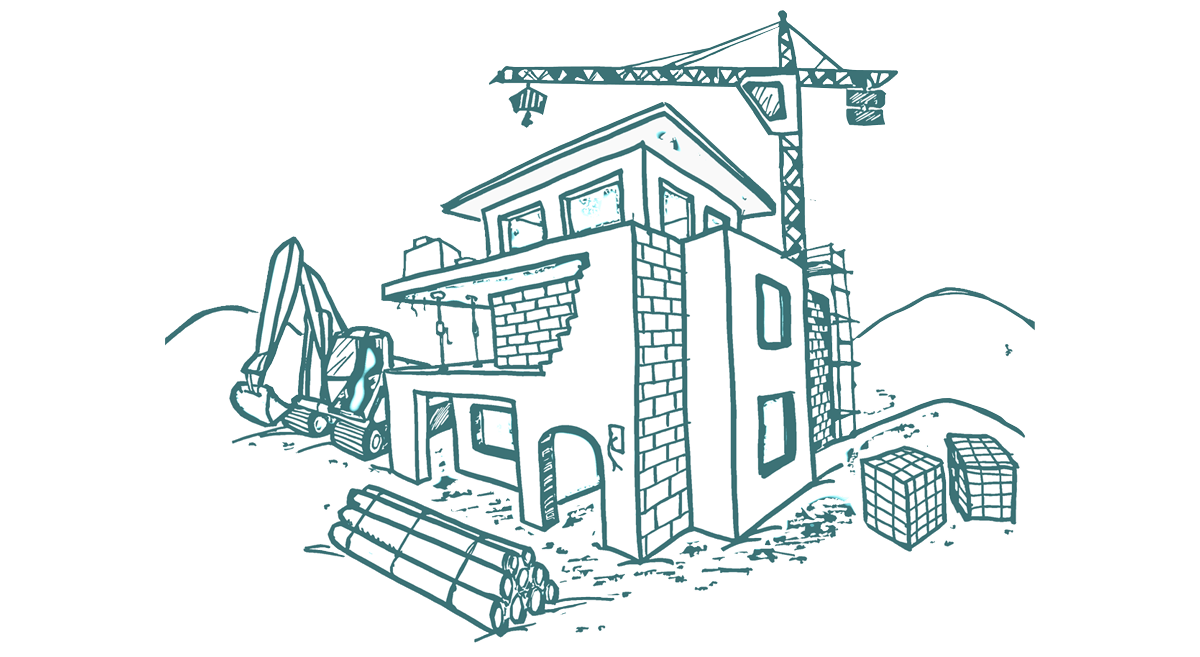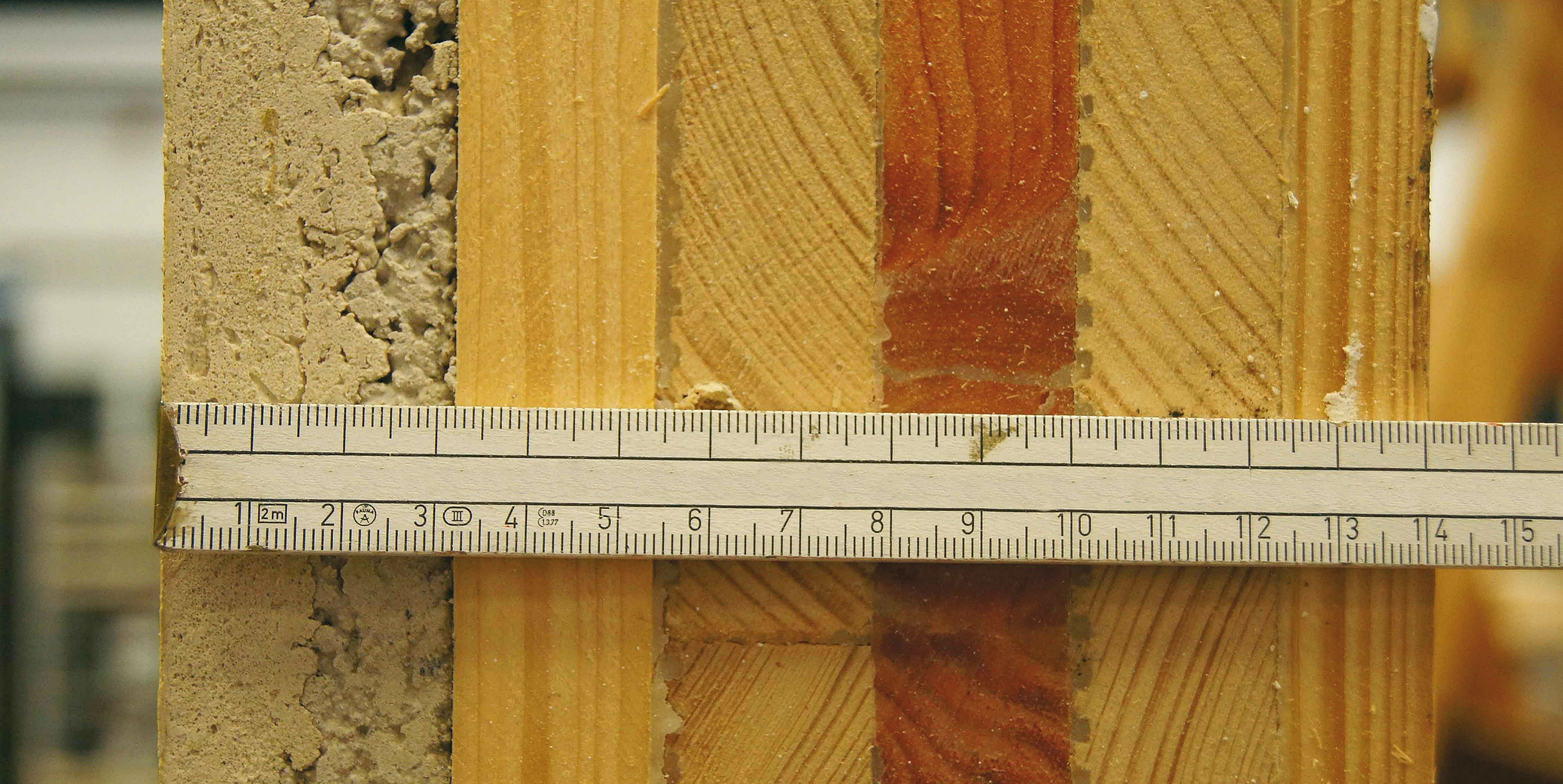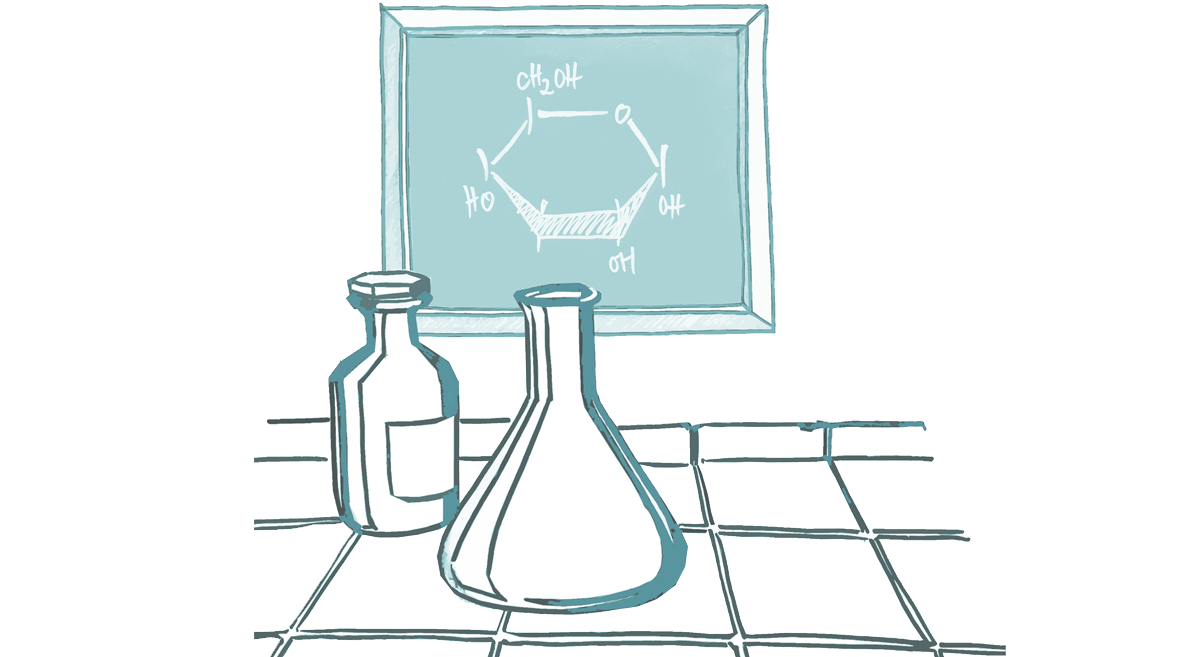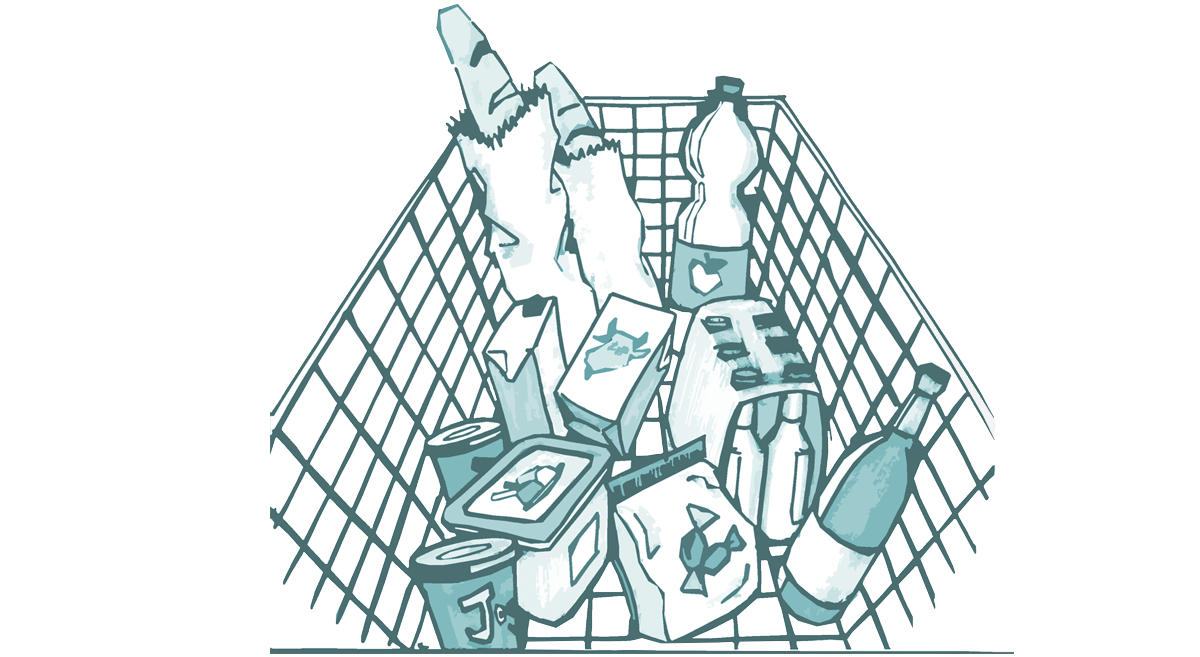Construction
As raw materials for building, general construction materials, insulation and materials for interior finishing work: regenerative raw materials are appealing owing to their good material characteristics. They improve environmental balance sheets and are often more compatible with human health. Within this context, natural construction materials are increasingly interesting not only for new building, but also for restoration. In addition, there are now bio-based strategies for greater sustainability with conventional products in the construction sector as well – for example, concrete and asphalt. A constructive contribution to bioeconomy.
FACTS & FIGURES
No. of companies:
325.100 (2014)
Employees:
1,91 Mio. (2014)
Sales:
€227 billion (2014)
(Source: Federal Institute for Research on Building, Urban Affairs and Spatial Development)
Examples of bioeconomy:
Wooden structures, composites reinforced with natural fibres, bio-based screw anchors

Since humans have built dwellings, they have used regenerative raw materials such as wood and straw as building materials. Since sustainability and energy efficiency have become increasingly important in the construction sector, the acceptance of bio-based materials is again on the rise. Wood, for example, is being more widely employed in constructive building. Bio-based binders are still in trials. To enhance added value in domestic agriculture and forestry, efforts increasingly go to enlarge the portfolios of natural sources for construction materials. There are likewise new approaches in structural and ground engineering – for example, in rendering petroleum-based processes in building chemistry more climate-friendly in the manufacture of concrete. The construction sector in Germany, with approximately 300,000 companies and 1,900,000 employees, is therefore of key importance in the further development of bioeconomy.
According to data from the Federal Bureau of Statistics, construction materials made of wood had a production value of approximately 14 billion euros in 2011. For lumber, this value was about 4 billion euros for planed and 4 billion euros for sawn wood. Owing to its superior characteristics, coniferous lumber contributes the majority here: in 2011 this was 21.6 million m³. For production of wood building materials, wood chips are glued and pressed in the form of board material. Chip board, the most important product in the wood-materials industry, achieved in 2011 a production value of 1.5 billion euros, with 5.7 million m³. These figures make wood the most important regenerative construction material. This is the result of its building- physics properties: it is not only flexible, light and easily worked – it is also good in load-bearing capacity, stable under pressure and extremely flexurally strong in processed form. An additional benefit is its sustainability: wood stores carbon, manufacture of wood products for construction takes less energy than do conventional construction products and demolition of wooden structures leaves behind no pollution. Binders and adhesives for wood, to be sure, are still primarily made from petroleum- based chemicals – but there are already bio-based alternatives whose effectiveness is currently being tested: for example, binders based on wheat protein and potato starch, lignin and tannin. The related research and development projects are at the focus of a new research funding program that the BMEL initiated in 2014.
A glance at materials used in new construction shows that the construction sector grants key priority to sustainability and energy efficiency. The use of natural material is increasing: already 15% of new buildings in Germany is now made of wood. Increasingly, architects are also using wood for load-bearing structural members. The nationwide competition for wood, HolzbauPlus, sponsored by the BMEL, has distinguished especially successful projects with this technology. In Berlin, for example, a number of five- and six-storey residential buildings have been recently constructed entirely of wood. The possibilities of advanced wood technologies, however, mean that experts see a far greater future for wood: for example, for construction of wind-turbine towers more than 100 m in height. The lumber company Pollmeier Massivbau in Thuringia, Germany, specialists in deciduous wood, plans the use of structural beech for such structures. The product is called BauBuche, an innovative material arising from rotary peeling of a beech trunk and bonding of the wood in layers. The result is a high-tech material suitable for structural wood construction. Pollmeier is a partner in the BioEconomy cluster in Central Germany, which received distinction as part of the Leading-Edge Cluster Competition BMBF 2012. This network concentrates on maximum added value and virtually complete use of beech trees.
Advanced wood material is not only potentially capable of reaching extreme heights: in a project funded by the BMEL, researchers at Chemnitz Technical University have examined the possibility of using wood materials to possibly replace supporting components made of steel or aluminium in what is called vertical conveyor technology. Conveyor systems are a key element in industrial production processes and play an important role in warehousing and materials-flow systems. A variety of transport systems is used, depending on the characteristics of the goods conveyed. Vertical systems are primarily required when complex production systems are involved, in order to move certain goods back and forth throughout various levels.
Manufacturers of fibre-reinforced composite materials are also increasingly turning to wood as a source of raw materials. This market has tremendously developed over recent years, with double-figure growth rates in some cases. The largest application area for natural-fibre-rein-forced composites is the automotive industry, but approaches are also being tested with respect to structural building components.
So-called wood-anhydrite composite systems, developed at Bauhaus University in Weimar, likewise contribute to greater sustainability in multi-storey buildings. Anhydrite is a naturally occurring substance similar to gypsum (calcium sulphate). Compared to concrete, it can be recovered and processed without great use of energy. In a highly impressive trial, engineers from Weimar have directly applied a screed of anhydrite onto wooden elements. The resulting composite components are solid and offer the benefits not only of great load-bearing capacity, but also create a pleasant and healthy room climate. In the project funded by the BMEL, researchers have worked with local small and medium-sized enterprises and with the company Maxit Baustoffwerke GmbH, which extracts the mineral in Thuringia – and which assures regional added value.Able to support great loads, and good for indoor climate: in wood-anhydrite composite systems, civil engineers from Bauhaus University in Weimar apply anhydrite, similar to gypsum, directly onto wood.
Able to support great loads, and good for indoor climate: in wood-anhydrite composite systems, civil engineers from Bauhaus University in Weimar apply anhydrite, similar to gypsum, directly onto wood.

In an age of energy-efficient construction and restoration, natural insulation materials also enjoy greater demand – their production requires less energy and they have positive effect on household climate and human health. In summer, natural materials provide good heat insulation. In addition, they can absorb great amounts of moisture and are in many ways allergy-friendly. Already today, the market share of insulation made from regenerative materials is approximately 7%. Coniferous trees, owing to their fibre characteristics, are primarily used to produce wood-fibre insulation. Research efforts in forestry have focused here on more efficient use of coniferous wood as raw material. Cellulose from defibrated old paper also serves as raw material for insulation. Also used here are hemp, flax, meadow grass, straw and sheep’s wool. Market-introduction programmes of the BMEL, by now concluded, systematically promoted the use of natural-fibre insulation in Germany. Between 2002 and 2008, a total of 17,000 home and flat owners had profited from this funding. The federal government furthermore promotes awareness of the application of natural paints – the market share of which is currently only 3%. They offer, however, many benefits: for example, wood surfaces treated with natural oils can continue to “breathe”. Also, a wall coated with casein-natural resin paint enhances indoor climate. Natural resin/latex glue emits no toxic vapour. Natural paints are produced from natural mineral and regenerative plant sources, and contain far less solvent. These benefits are not offered by conventional chemical products such as acrylic and alkyd products, or by reaction, nitro or polyurethane lacquers. The most important of more than 100 natural-paint products include wall paints, wood finishing agents, natural-resin paints, oils and waxes.
Regenerative raw materials play a greater and more extensive commercial role for flooring. They provide the basis for wood flooring such as parquet, floor boards and laminate – as well as cork and sisal flooring. Linoleum consists primarily of linseed oil, cork and wood dust, pulverized limestone, pigments as well as jute fabric as supporting layer. Current efforts in the sector have addressed the need to increase the use of domestic wood. One good example is the company Timura Holzmanufaktur GmbH from the Wood Cluster Rottleberode in the South Harz district: a key raw materials supplier to the Central German Leading-Edge Custer BioEconomy. Timura has developed, for example, a thermal process for enhancing domestic wood to provide it with the properties of tropical products. Floor boards that are treated with special heating plates are more durable than conventional wood; they are virtually odourless and can be produced in many colour shades.
Currently, the least sustainable area in the construction sector is chemistry – particularly for the production of concrete, the most important basis for structural and ground construction. Cement, the binding agent for concrete, requires many resources for its production, including water. There are, however, new approaches here as well. With funding by the BMBF, an alliance headed by the biotechnology company Evocatal from Dusseldorf has set the objective of developing a bio-based concrete liquefier that would save even more water than current products.
Already today, other concrete liquefiers reduce water consumption for mixing concrete by around 15%. These agents also assure that the concrete remains flowable for a long time and that it can support extremely high loads after setting. Until now, however, these high-performance liquefiers were produced from petroleum. For production of a bio-based variant, Evocatal works with innovative enzymes. These enzymes can transform waste products from cellulose factories into processable products. Paper manufacture, for example, produces around 50 million tons of the wood substance lignin every year around the world. With the aid of special enzymes, lignin can be transformed to an interesting substitute for concrete. Together with the partners of this alliance, biotechnologists have already disclosed prospective enzymes that could create a rugged and innovative product from the natural substance lignin.
Plant starch is another biopolymer suitable as concrete substitute. This carbohydrate, for example, can be added to shotcrete as used in tunnel construction. Starch ether obtained from maize is added to a mixture of sand and cement. This enables shotcrete to adhere better to walls, and it reduces the material and energy required for lining tunnel walls. In a BMEL-funded project, researchers of the Südzucker corporate group have experimented here with starch molecules that are additionally provided with chemical appendages. At test facilities at Ruhr University in Bochum, this maize-starch additive especially enabled fast early strength of shotcrete – a characteristic much appreciated among tunnel builders.
Asphalt made of discarded frying oil
For street construction, researchers have also experimented with bio-based asphalt. Sticky bitumen can be produced from bio-waste: for example, from vegetable oil discarded from frying in the catering trade. Mixed with flue ash from coal-fired power plants, this waste oil goes to produce asphalt that in initial testing has already revealed interesting properties. Further testing will be necessary to determine whether such bioasphalt is effective in uses for rugged and long-lived street and road surfacing.








